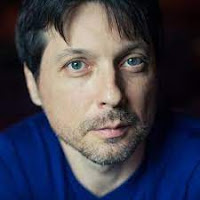 |
| Tzvi Avni (tzviavni-composer.com) |
 |
| Juan Pérez Floristán ©Yoel Levy |
The Israel Camerata Jerusalem is currently celebrating its 40th anniversary. Taking place at the Tel Aviv Opera House on March 26th 2024, "Mozart in Prague", an event of the orchestra's InstruVocal Series, was conducted by its founder/musical director, Maestro Avner Biron. Soloist was Spanish pianist Juan Pérez Floristán, winner of the 2021 Arthur Rubinstein International Piano Master Competition.
Setting the geographic scene was
Concerto à 8 concertanti by Jan Dismas
Zelenka (1679-1745). Born in a market town
southeast of Prague, Zelenka's
career took him to the Dresden court of Friedrich Augustus the Strong, Elector
of Saxony and King of Poland, where he served as a double bass player and
composer. Primarily a vocal
composer, Zelenka's instrumental works mostly date from around the time
the composer was apprenticed to Johann Joseph Fux. The Camerata's reading of
Concerto à 8 highlighted the composer's contrapuntal mastery and harmonic
inventiveness (qualities admired by contemporaries J.S. Bach and
G.P.Telemann!), the performance also offering interest and variety in the many
solo passages and dialogues performed by orchestra members, to the delight of
the audience.
Soloing in W.A.Mozart's
Piano Concerto No.20 in D minor K.466, Juan
Pérez Floristán (literally) joined the Camerata players in a performance to
remember. One of only two Mozart concertos in a minor key (and the stormier of
the two) Floristán addressed the darker, dramatic elements of the 1st movement
(Allegro) with rigour and pathos rather than with furore. Added to that were
much poignancy and luminosity, crisp fingerwork, unburdened pedalling and
finely contrasted dynamics. As to the Beethoven cadenza Floristán chose for the
1st movement (Mozart left no cadenzas to the work), the pianist took the
listener through a range of gestures, from the most intimate and delicate to
full-on, rich piano textures. Both artist and orchestra lavished the 2nd
movement (Romanza) with empathy, the soloist eloquently threading melodies
through the weave. Floristán's playing of the stormier middle section emerged
intense, the movement's closing
feather-light ascending arpeggio then to fade away to a faint whisper. In the final movement, the soloist gave expression to its
variety of moods, transitioning naturally from touch to touch and engaging in
playful banter with the woodwinds as he addressed the shape of each tiny detail
of the Mozart score. Choosing András Schiff's cadenza for the Rondo, Floristán
captivated the listener with its variety, rich voice-play and grace. The
concerto's first performance took place at the Mehlgrube Casino in Vienna on
February 11th 1785, with the composer as the soloist. In a letter to Nannerl (Mozart's
sister), Leopold Mozart wrote of the event: "We had a new and very fine
concerto by Wolfgang, which the copyist was still copying as we arrived, and
the rondo that your brother did not even have time to play through, as he had
to supervise the copying.” Although not performed on period instruments, the
modest size of the Israel Camerata Jerusalem, together with Floristán's
fine-spun handling of the text made for a personal and moving Mozart
experience.
For his encore,
Juan Pérez Floristán (b.1993) performed Debussy's "Girl with the Flaxen
Hair", his rendering of the musical "portrait" discerningly
paced, evocative and lush.
Tzvi Avni
(b.1927,Saarbrücken, Germany, in Israel since 1937) composed four string
quartets over nearly sixty years; the most recent of them - "About These
Days" (2021) - was first performed in Germany. At the request of Maestro
Biran, Prof. Avni arranged the piece for string orchestra. This was the setting heard
at the Tel Aviv concert. A single-movement work of no defined musical form, it
gives expression to the anxiety pervading the general mood during the Corona
pandemic. Opening with dense eighth- and sixteenth-note chords established in
the two opening measures, the second, melody-based subject forms a strong
contrast to it. There is no mistaking the dark, introspective message of the
piece, with its plangent solos, its mood as relevant today as when it was written. The Camerata string players gave a dedicated, affecting performance of
the piece, its tension here and there giving way to freer-flowing passages, the work then drawing to an end on a major chord. The composer was present at the
performance.
Reconnecting with
the evening's theme, Maestro Biron and the Camerata players concluded the event
with a substantial testimonial to the Bohemian connection. W.A.Mozart's music
was all the rage in Prague at the end of 1786. Bringing Symphony No.38 in
D major ("Prague") K.504 with him from Vienna, the composer travelled
to Prague in early 1787, where it was to be premiered. Although not actually
composed there, the lavish use of wind instruments in this symphony takes into
account that the wind players of Bohemia were famed throughout Europe. With his
symphonic style at its most sophisticated, the work also marks the beginning of
a late period in Mozart’s symphonies, showing him pushing at the bounds of the symphonic form (there is no Minuet). Together with its darker moments, its
complex counterpoint with a rich array of voices and the play of smaller
instrumental groups as against larger, the Camerata performance left no doubts
as to the references Mozart was making to his written- and not-yet-written
operas. A symphony for connoisseurs, K. 504 reflects the taste and
discernment of the audience for which it was intended. Here, in Tel Aviv, energy
and lyricism abounded, sparkling virtuosity, and humour, as did opportunities
to enjoy the orchestra's fine wind playing.

Maestro Avner Biron (Courtesy JAMD)











